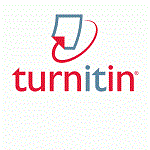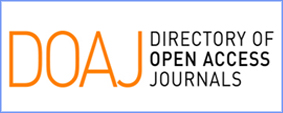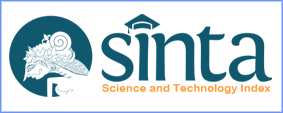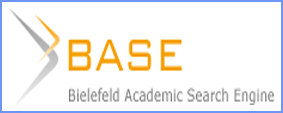Enhancing Creative Thinking Ability of Students in Probability Topics Through React Learning
Abstract
This study aimed to improve creative thinking ability of students through REACT learning strategy approach in probability topics. REACT learning strategy approach has 5 stages, consist of Relating, Experiencing, Applying, Cooperating, and Transferring. The type of research is Classroom Action Research. The study population was twelfth grade students of SMAN 1 Nglames, and the sample used was one class of XII MIA 2 consist of 32 students. The data collection technique uses (1) test scores of students' creative thinking skills which include the initial and final tests, (2) the results of observations during the learning process, (3) the results of interviews with the subject of the interview. Data were analyzed through descriptive analytic techniques. Based on the data analysis, it was found that each component of creative thinking had the following percentage increase in fluency (5.22%), flexibility (8.81%), originality (21.57%), and elaboration (29.29%). The results showed that REACT learning through three stages, namely the initial stage, the core (Relating, Experiencing, Applying, Cooperating, and Transferring), and the closure can improve students' creative thinking skills, especially in the probability topics.
Keywords
Full Text:
PDFReferences
Bosch, N. (1997). Rubric for Creative Thinking Skills Evaluation. Online. Retrieved from www.adifferentplace. org/creative thinking htm.
Fauziah, A. (2010). Peningkatan Kemampuan Pemahaman dan Pemecahan Masalah Matematika Siswa Melalui Strategi REACT. Forum Kependidikan, 30(1), 1–13.
Filsaime, D. K. (2008). Menguak Rahasia Berpikir Kritis dan Kreatif. Jakarta: Prestasi Pustaka.
Herlina, S., Turmudi, & Dahlan, J. A. (2012). Efektivitas Strategi REACT dalam Upaya Peningkatan Kemampuan Komu-nikasi Matematis Siswa Sekolah Menengah Pertama. Jurnal Pengajaran MIPA, 17(1), 1–7.
Jelatu, S., Sariyasa, & Made Ardana, I. (2018). Effect of GeoGebra-aided REACT strategy on understanding of geometry concepts. International Journal of Instruction, 11(4), 325–336. https://doi. org/10.12973/iji.2018.11421a
Kemmis, & Taggart., M. (1990). The Action Research Planner. Melbourne: Deakin Univercity.
Margono. (2000). Metodologi Penelitian Pendidikan. Jakarta: Rineka Cipta.
Mulyasa. (2009). Menjadi Guru Profesional Menciptakan Pembelajaran Kreatif dan Menyenangkan. Bandung: Remaja Rosdakarya.
Munandar, U. (2009). Pengembangan Kreatifitas Anak Berbakat. Jakarta: Rineka Cipta.
Nelson, P. M., Demers, J. A., & Christ, T. J. (2014). The responsive environmental assessment for classroom teaching (REACT): The dimensionality of student perceptions of the instructional environ-ment. School Psychology Quarterly, 29(2), 182–197. https://doi.org/10.1037/spq00 00049
Nuriadin, I., & Perbowo, K. S. (2013). Analisis Korelasi Kemampuan Berpikir Kreatif Matematik Terhadap Hasil Belajar Matematika Peserta Didik Smp Negeri 3 Lurangung Kuningan Jawa Barat. Infinity Journal, 2(1), 65. https://doi.org/10. 22460/infinity.v2i1.25
Patimah, L. (2016). Penerapan Strategi Relating, Experiencing, Applying, Cooperating dan Transfering (REACT) untuk Meningkatkan Kemampuan Berpikir Kritis dan Kreatif Matematis Siswa. UNIVERSITAS PASUNDAN BANDUNG. Retrieved from http:// repository.unpas.ac.id/5184/
Rahayu, E., Susanto, H., & Yulianti, D. (2011). Pembelajaran Sains Dengan Pendekatan Keterampilan Proses Untuk Meningkatkan Hasil Belajar Dan Kemampuan Berpikir Kreatif Siswa. Jurnal Pendidikan Fisika Indonesia, 7(2), 106–110. https://doi.org/10.15294 /jpfi.v7i2.1081
Siburian, J., Corebima, A. D., Ibrohim, & Saptasari, M. (2019). The correlation between critical and creative thinking skills on cognitive learning results. Eurasian Journal of Educational Research, 2019(81), 99–114. https://doi.org/10.14 689/ejer.2019.81.6
Sumarmo, U. (2005). Pengembangan Berpikir Matematis Tingkat Tinggi Siswa SLTP dan SMU serta Mahasiswa Strata Satu melalui Berbagai Pendekatan Pembel-ajaran. Bandung.
Ültay, N., Durukan, Ü. G., & Ültay, E. (2015). Evaluation of the effectiveness of conceptual change texts in the REACT strategy. Chemistry Education Research and Practice, 16(1), 22–38. https://doi. org/10.1039/c4rp00182f
Article Metrics
Abstract has been read : 898 timesPDF file viewed/downloaded: 0 times
DOI: http://doi.org/10.25273/jipm.v8i1.4443
Refbacks
- There are currently no refbacks.
Copyright (c) 2019 JIPM (Jurnal Ilmiah Pendidikan Matematika)

This work is licensed under a Creative Commons Attribution-ShareAlike 4.0 International License.
View JIPM Stats
JIPM indexed by:
Copyright of JIPM (Jurnal Ilmiah Pendidikan Matematika) ISSN 2502-1745 (Online) and ISSN 2301-7929 (Print)













